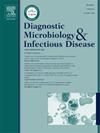Analysis of Predictive Factors for Mycoplasma-associated Plastic Bronchitis in Children
IF 1.8
4区 医学
Q3 INFECTIOUS DISEASES
Diagnostic microbiology and infectious disease
Pub Date : 2025-08-22
DOI:10.1016/j.diagmicrobio.2025.117073
引用次数: 0
Abstract
Objective
In recent years, the prevalence of Mycoplasma pneumoniae infection has led to complications such as mycoplasma-associated plastic bronchitis (M-PB) in some children. Therefore, it is particularly important to identify the predictive factors of M-PB occurrence and make early diagnosis and treatment.
Method
Analyze the pathogen of PB and collect 32 cases of M-PB and 60 cases of non-morphological mycoplasma pneumonia (N-PB) for comparative analysis.
Result
(1) A total of 126 cases of plastic bronchitis (PB) were collected, and the main pathogens were as follows: among them, 112 cases were combined with mycoplasma infection, 16 cases were combined with rhinovirus, 15 cases were combined with Streptococcus pneumoniae and Haemophilus influenzae respectively, 10 cases were combined with adenovirus, 5 cases were combined with bocavirus, 5 cases were combined with Moraxella catarrhalis, 3 cases were combined with Staphylococcus aureus, and 3 cases were combined with influenza A and B viruses respectively. (2) Binary Logistic regression analysis showed that the duration of fever and the ratio of neutrophils to lymphocytes (NLR) in blood were independent predictors of M-PB occurrence. The duration of fever (OR 1.525, 95% confidence interval: 1.112-2.089, P = 0.009), and NLR (OR 1.738, 95% confidence interval: 1.121-2.694, P = 0.013) (as shown in Table 3).
Conclusion
The main pathogen of plastic bronchitis is mycoplasma, and most of them are resistant to macrolide antibiotics. Other pathogens include rhinovirus, Streptococcus pneumoniae, Haemophilus influenzae and adenovirus. The duration of fever and NLR are independent predictive factors for the occurrence of mycoplasma-related plastic bronchitis.
儿童支原体相关塑料支气管炎的预测因素分析
目的近年来,肺炎支原体感染的流行已导致部分儿童出现支原体相关性塑料支气管炎(M-PB)等并发症。因此,识别M-PB发生的预测因素,早期诊断和治疗显得尤为重要。方法对肺炎支原体病原体进行分析,收集32例M-PB和60例非形态支原体肺炎(N-PB)进行对比分析。结果(1)共收集塑料支气管炎(PB) 126例,主要病原菌如下:其中合并支原体感染112例,合并鼻病毒16例,合并肺炎链球菌和流感嗜血杆菌15例,合并腺病毒10例,合并bocavavirus 5例,合并卡他莫拉菌5例,合并金黄色葡萄球菌3例,合并甲型流感病毒和乙型流感病毒3例。(2)二元Logistic回归分析显示,发热持续时间和血液中性粒细胞/淋巴细胞比值(NLR)是M-PB发生的独立预测因子。发热持续时间(OR 1.525, 95%可信区间:1.112 ~ 2.089,P = 0.009)和NLR (OR 1.738, 95%可信区间:1.121 ~ 2.694,P = 0.013)(见表3)。结论塑性支气管炎主要病原菌为支原体,支原体对大环内酯类抗生素耐药较多。其他病原体包括鼻病毒、肺炎链球菌、流感嗜血杆菌和腺病毒。发热持续时间和NLR是支原体相关性塑料支气管炎发生的独立预测因素。
本文章由计算机程序翻译,如有差异,请以英文原文为准。
求助全文
约1分钟内获得全文
求助全文
来源期刊
CiteScore
5.30
自引率
3.40%
发文量
149
审稿时长
56 days
期刊介绍:
Diagnostic Microbiology and Infectious Disease keeps you informed of the latest developments in clinical microbiology and the diagnosis and treatment of infectious diseases. Packed with rigorously peer-reviewed articles and studies in bacteriology, immunology, immunoserology, infectious diseases, mycology, parasitology, and virology, the journal examines new procedures, unusual cases, controversial issues, and important new literature. Diagnostic Microbiology and Infectious Disease distinguished independent editorial board, consisting of experts from many medical specialties, ensures you extensive and authoritative coverage.

 求助内容:
求助内容: 应助结果提醒方式:
应助结果提醒方式:


